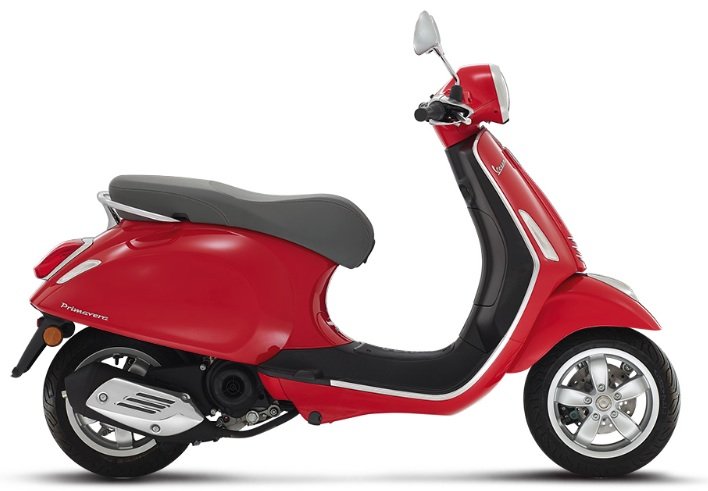VESPA PRIMAVERA
The Primavera nameplate – meaning “spring” in Italian – has been revived by Vespa for their third generation of modern small frame scooter. Launched in spring 2014 as a 2015 model, the Primavera builds off the small frame success of the ET series (launched 1996) and LX / S series (launched 2006), with a new generation bearing obvious influence from Vespa’s flagship 946 model. The result is a beautiful new generation of Vespa.
The Primavera is now offered globally with a choice of two motors. A smaller 50cc option will be offered in each country, but the specific engine will vary between either a 4-stroke (most countries) or a 2-stroke (where allowed). Accompanying the 50cc will be a larger 125cc or 155cc option. Countries with learner laws favouring 125’s will get the 125cc Primavera (ie. UK) while elsewhere buyers will be offered a larger 155cc version. In the USA and Canada, Vespa is offering their 50cc 4-stroke and 155cc 4-stroke motor options.
Models
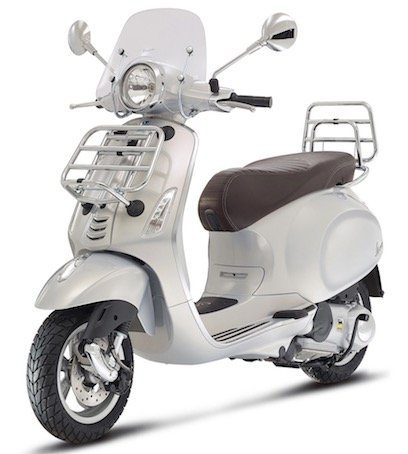
As well, Vespa offered a limited “70th anniversary” edition called the Settantesimo for 2016. This edition was offered for both 50cc and 150cc Primavera’s and added a dark brown seat and rear luggage bag, as well as gunmetal finished rims and 70th anniversary logos throughout. This model was available in either Azzurro Metallizzato (Robin’s Egg Blue) or Grigio Pulsar (light grey) for an extra $300
Styling
As Vespa’s third generation of modern small frame scooters, the Primavera design continues to mark new ground. In the same way that the GT200 served as a stylistic inspiration for the LX series, Vespa’s new 946 design is the clear inspiration for the Primavera. It could easily be argued that the Primavera is a 946 for the masses, as it foregoes frills like ABS, traction control and hand stitching in exchange for an MSRP around half.
In contrast to the LX, the new Primavera has a longer, angular design which includes an extra 2” of wheelbase and 4” of total length (69.1” vs. 73.2”). Most notably, the rear end has gone from a short bulge to an elongated and pointed sculpture befitting of a wasp. It looks faster just parked. Perhaps the best line on the Primavera is the bottom edge of the rear flanks, which slopes downward and flows in the tilted floorboard. In the LX these lines were near horizontal and disjunct. This change alone makes the Primavera look ready to pounce.
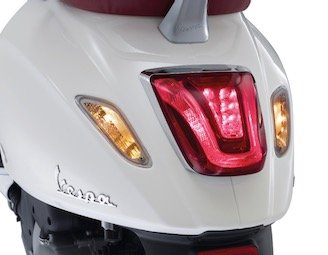
Globally, Vespa is offering the Primavera in 6 color options: light blue, dark blue, red, brown, white and black. Of course you won’t find those descriptions on Vespa’s specs sheets. In the same order, Vespa is calling these colors Marechiaro Light Blue, Blue Midnight, Dragon Red, Crete Senesi Brown, Montebianco White and Volcano Black.
Motors
North Americans can select from 50cc 4-stroke and 155cc 4-stroke options, with the 2-stroke 50cc option only offered overseas. The more powerful 155cc option is a 3-valve design which is also available in some overseas markets in smaller bore version (52 mm vs 58 mm) to meet 125cc learner rules there. At 155cc, the larger version of the Primavera is legal on interstate highways in all 50 states, which makes it more practical than a 125cc machine would be. The motor is the same core engine as that found in Vespa’s high end 946 scooter and a few overseas 2013 models of the LX 150. (North American LX 150’s never received this update). Unlike the 946, this motor in the Primavera lacks traction control, which is just as well since traction control is fairly superfluous in a small scooter and adds to the cost.
This recently developed Piaggio motor is a great step forward for the Italian maker, as it incorporates both fuel injection and 3-valves to increase power and fuel economy. The result is a healthy 12.7 HP for the 155cc model (vs. 10.6 ponies for the 125cc), which is up 0.7 HP from the current fuel injected LX and up a full pony compared to older model LX scooters. Thus far the only milage estimates for the Primavera are Piaggio’s optimistic 100-120 mpg claims. It’s safe to say you’ll never see that without substantial intention, but the Primavera should easily best the 65-75 mpg that the LX generation was capable of in real world conditions. 80 mpg is a good estimate for mixed real world use. Top speed for the Primavera should be an easy 60-65 mph. The LX 150 was claimed at 59 mph, yet it could wander to 60 – 65mph so I wouldn’t be surprised to see the Primavera wandering to 65-70 mph.
Besides the larger flagship engine, Vespa is also equipping the Primavera with 4-stroke and 2-stroke 50cc motor options. North American’s are being offered only the 4-stroke 50, which is similar to the strategy Vespa took with the LX. Indeed, the 50cc 4-stroke motor offering is the same Hi-PER4 motor that is also found in the LX and S 50. This motor makes a decent 4.6 HP which translates to a reasonable 40mph top speed. The use of this older motor saves quite a bit on the MSRP (about $1000), but it also doesn’t take full advantage of this scooters’ design (i.e. high end frame, suspension, brakes etc), nor does it offer as good of fuel economy as some other fuel injected 50cc scooters. If finances or road rules are constraining you to a 50cc then you’ll still have a great machine, but the 155cc is where this scooter will really come alive.
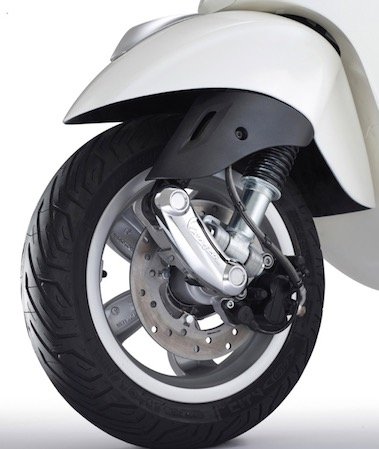
Brakes / Suspension / Handling
With the Primavera, Vespa has made substantial improvements to the three handling weakness of their previous small frame scooters: high seat height, short wheelbase and small wheels. The Primavera shaves a small but appreciated 0.3” off the seat height of the old LX, which in conjunction with the extra 2” of wheelbase should improve high speed handling. This isn’t an issue with the slower 50cc models, but bumpy corners at 60mph were a bit unnerving on the LX. The Primavera should fair better in this regard. Also benefitting its’ handling is an upsized rear wheel. The front wheel remains at 11” in the Primavera with the same 110/70 rubber, while the rear wheel gains an inch of diameter to join the front at 11”. In addition to improving tire life, this should deliver a little extra stability at speed. The larger rim also enables a move to a larger rear drum brake. The Primavera employs a 140mm rear drum brake, which is a substantial improvement over the 110mm rear brake found in previous small frame Vespa’s. If you’re really after good brakes though, Vespa’s similar Sprint model includes standard ABS.
 Storage & Convenience
Storage & Convenience
Vespa’s have always been practical – aside from the storage-free 946 – and the Primavera continues to take steps forward in this regard. This new Vespa incorporates a glove box of similar size as the previous generation but it’s been made more usable with the addition of half walls that avoid the challenge of quickly shutting the door before your stuff falls out. Rear storage is also increased by 16% to 16.6 liters (4.4 gallons) so now even XL full face helmets should fit with ease.
A number of other appreciated conveniences carry over from Vespa’s older models. These include push to cancel blinkers, a microchipped key theft deterrent system, a locking steering column (also to foil thieves).
Comparison
Unlike most scooters, there is really no comparing to a Vespa except for other Vespa’s. Prospective Primavera buyers should have a look at the Sprint, which is just a styling variation of the same core model but with standard ABS. Buyers may also want to consider a discontinued Vespa LX if they find a deal.
There are quite a few Vespa inspired scooters out there, but none of them match a real Vespa in design quality (i.e. real chrome, metal body). In the 50cc segment, Honda offers the Metropolitan/Giorno, while Yamaha offers the Vino 50. Both cost much less, but they also cost much less to make. That’s not to say they aren’t great scooters. Indeed both Yamaha and Honda make outstanding reliable machines. They just aren’t the timeless work of art that a Vespa is. Other more affordable options are Kymco’s Like 50 and Sento/Compagno 50 machines. All of these are good machines. Enthusiasts will be better served with the Vespa, while buyers looking for an affordable commuter scooter are better off buying something costing less.
The larger Primavera 155 really only competes with Kymco’s Like 200 now that Yamaha has discontinued the Vino 125 – and even that comparison is a stretch as these machines land at opposite ends of the pricing spectrum. The Like 200 (which is actually 163cc) lags the Primavera in technology and thus is likely slower in addition to being more fuel hungry. At $2699, the Like 200 makes it tough for non-enthusiasts to justify a Vespa, but for buyers who are interested in more than just basic transportation the Primavera is the more compelling machine. The 2015 Primavera lists for $3599 (50cc) or $4899 (155cc), while in Canada the 2015 MSRP is $3895 / $5095 (50cc/155cc).
If you’re reading this, you probably already know if a Vespa is for you. If you can afford a Vespa then go for it. Don’t pass on what you love to save a little money. You’ll never regret spending a bit more for a machine this nice. However if you’re simply after a frugal way to get around then look at the Japanese and Taiwan makers.
Pros:
- Great fuel injected motor
- All metal construction
- Great style
Cons:
- Expensive
- Air cooled
- Carburated (50cc)
Links:
Primavera 150 Service Manual – Essential for the DIY mechanic
MotorscooterGuide Forums – Visit the forum on this site to chat about this scoot.
Modern Vespa Forums – Lots of knowledgeable Vespa owners here.
Key Specs:
- Engine: 49cc Hi-PER4 4-valve 4-stroke or 149.8cc SOHC 3-valve 4-stroke
- Other International Motor Options: 49cc 2-stroke Hi-PER2 or 124.5cc SOHC 3-valve 4-stroke
- Fuel Delivery: Carb (50cc) or Fuel injection (150cc)
- Cooling: Air cooled
- Transmission: CVT
- 50cc Power: 4.6 HP @ 9500 RPM & 2.8 ft-lbs torque @ 8000 RPM (4-stroke)
- 150cc Power: 12.7 HP @ 7750 RPM, 9.4 lbs-ft torque @ 6500 RPM
- Bore & Stroke: 39.0 x 41.8mm (4-stroke 50cc) or 58.0 mm x 58.6 mm (150cc)
- Compression Ratio: 10.5:1
- Drive: Belt
- Wheelbase: 52.4” (133 0mm)
- Weight: 240 / 260 lbs (50/150cc)
- Starter: Electric
- Seat height: 30.7”
- Fuel Tank: 7L / 1.8 gal (50cc) or 8L / 2.1 gal (150cc)
- Brakes: 200mm disc (Front), 140mm drum (Rear)
- Front Suspension: Single arm coil shock, 3.1” (78mm) travel
- Rear Suspension: Single shock, 2.7” (69mm) travel
- Tires: 110/70-11, 120/70-11 (Front, Rear)
- Years Sold: 2015 – Present
- USA 2015 MSRP: $3599 (50cc) or $4899 (155cc)
- Canada 2015 MSRP: $3895 (50cc) or $5095 (155cc)
Primavera 50 Colors:
- 2015 USA: Montebianco White, Blue Midnight, Dragon Red, Light Blue
- 2015 Canada:Montebianco White, Midnight Blue, Dragon Red, Light Blue, Crete Brown, Volcano Black
- 2016 USA: Montebianco White, Blue Midnight, Dragon Red, Volcano Black
- 2016 Canada: Montebianco White, Dragon Red, Volcano Black
- 2017 USA: Montebianco White, Volcano Black, Dragon Red, Azzurro Incanto
- 2017 Canada: Montebianco White, Volcano Black, Dragon Red, Azzurro Incanto, Midnight Blue,
- 2018 USA & Canada: Montebianco White, Volcano Black, Dragon Red, Azzurro Incanto, Coral Rose
Primavera 150 Colors:
- 2015 USA: Montebianco White, Blue Midnight, Dragon Red, Light Blue, Crete Brown, Volcano Black
- 2015 Canada: Montebianco White, Dragon Red, Volcano Black
- 2016 USA Montebianco White, Blue Midnight, Dragon Red, Volcano Black
- 2016 Canada: Montebianco White, Dragon Red, Volcano Black
- 2017 USA: Montebianco White, Volcano Black, Dragon Red, Azzurro Incanto
- 2017 Canada: Montebianco White, Volcano Black, Azzurro Incanto
- 2018 USA: Montebianco White, Volcano Black, Dragon Red, Azzurro Incanto, Coral Rose
- 2018 Canada: Montebianco White, Volcano Black, Azzurro Incanto
Primavera Tourer 150 Colors:
- 2016 USA: Grigio Seta
- 2018 USA: Verde Portofino

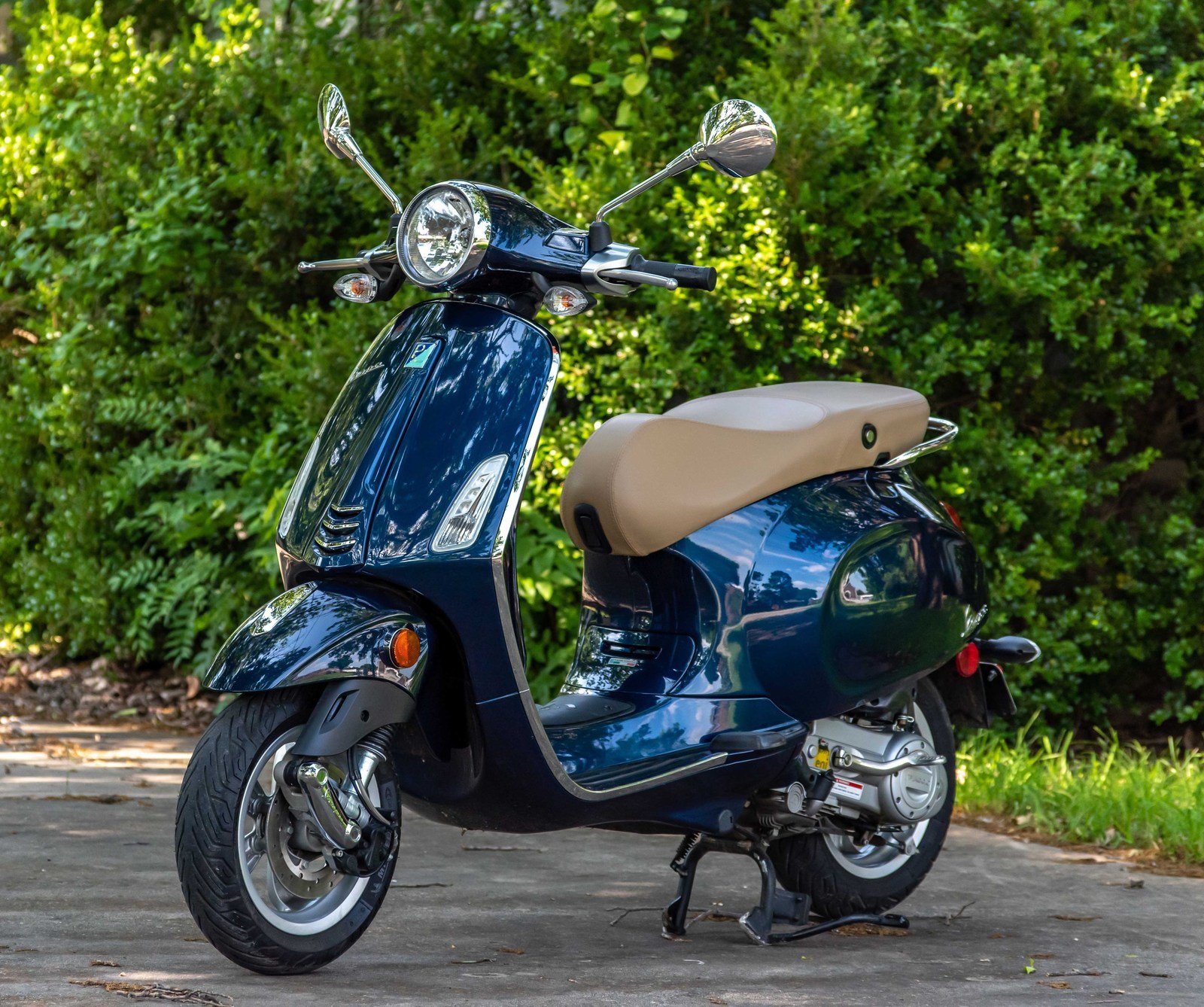
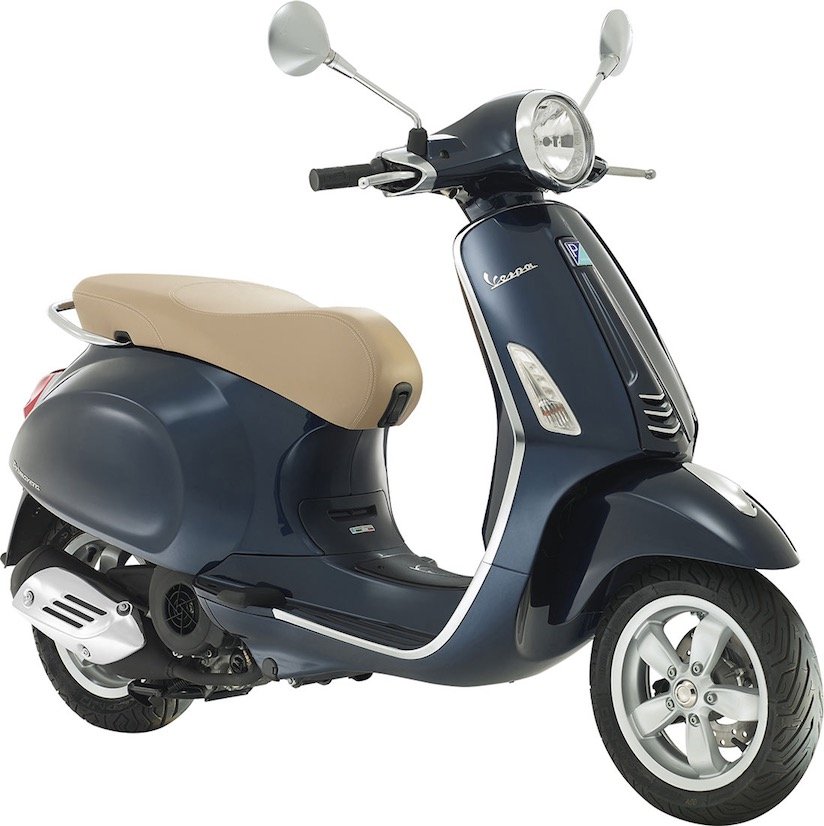
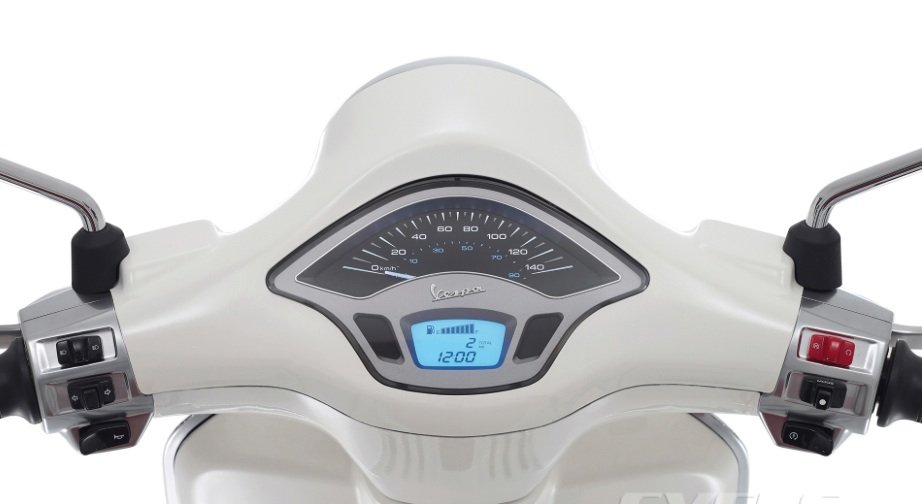
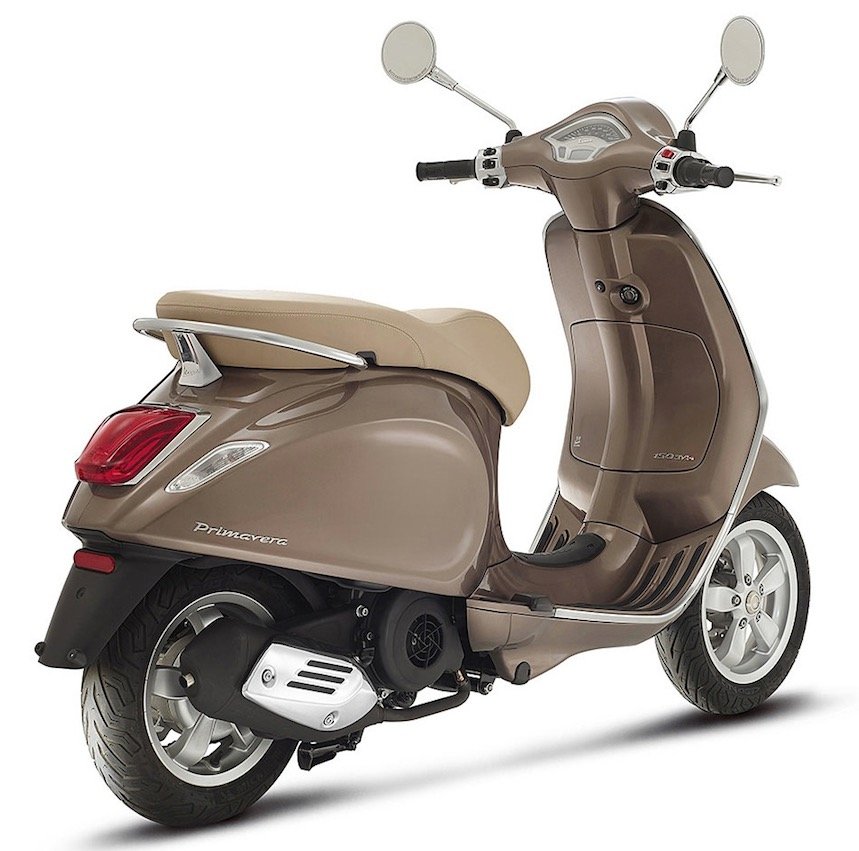
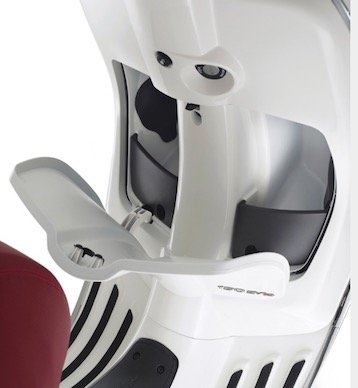 Storage & Convenience
Storage & Convenience